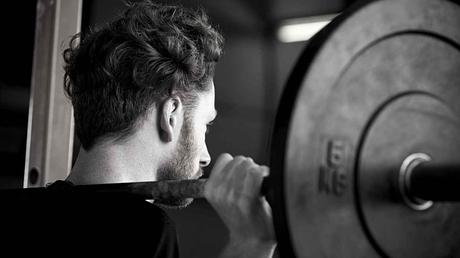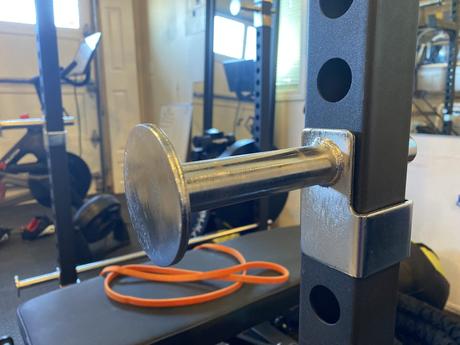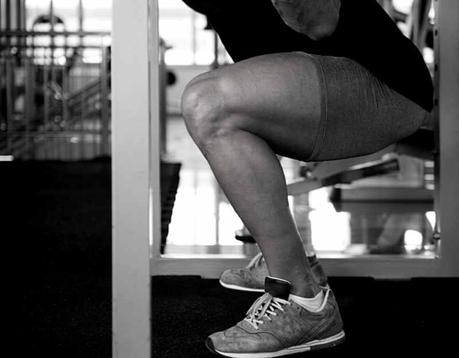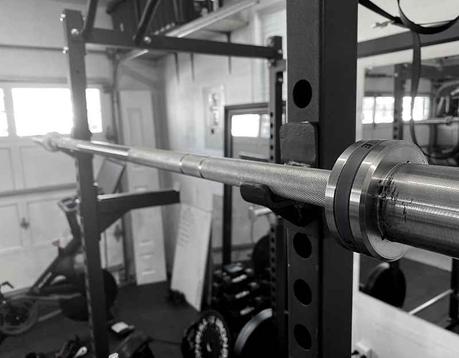Power racks are for much more than just doing squats. Here’s how to use a squat rack for a total lower body workout, and the best leg exercises to use on your journey to more muscle and strength.

Leg Day is the best day!
Sure, it’s also the toughest day, but it’s the day you get to hammer your lower body—quads, hamstrings, glutes, and calves—to facilitate better movement, increase mobility, and train for greater strength.
Training your legs will make you a better athlete and improve your agility and movement across every activity, be it sports, hiking, walking, snowboarding, or swimming.
Thanks to squat racks, you can take your Leg Day training to the next level.
Below, I’ve compiled a list of the all-time best squat rack leg exercises to step your training up a notch.
The next time you hit the gym, whether it’s down the road at the local Big Box gym, or down the hall in your garage, you’ll see big muscle growth and serious improvement in your coordination and agility.
Let’s get started.
Benefits of Using a Rack for Leg Exercises and Workouts
There are a lot of reasons to consider using racks (both a squat rack and power rack) for your training, but in this article, we’re going to focus specifically on squat racks and how they can help you.
Let’s start off by listing the primary benefits below:
 Benefit 1: Greater Safety
Benefit 1: Greater Safety

The greatest benefit of training with a squat rack is that it’s much safer than training without one.
Let me explain…
When you train your legs using just a barbell with no rack, you have to lift the barbell from the ground, then raise it over your head, and settle it onto your shoulders.
Throughout all of this, you’re putting various joints—including your wrists, elbows, shoulders, and lower back—at risk moving a heavy barbell across so many planes of movement.

And that’s just before you get training! Once you start knocking out those reps, you may find that you’re struggling to complete the set as you approach muscle failure.
What happens when you need to unload the weight but your legs can’t complete that last rep or two?
You’ve got to drop the bar behind you, which could be dangerous to not only yourself, but anyone or anything behind you, not to mention the risk of damage to the floor and the weights.
No, if you’re going to do any kind of heavily loaded leg exercise, you NEED a squat rack.
The attachments that come with a power rack (J-hooks, safety pins, spotter arms, etc) gives you a safe place to store the weight between sets, and makes it easier and safer to re-rack the weight if you’re struggling.
You’ll be able to train without a spotter because the rack helps to do the spotting for you.
 Benefit 2: Less Energy Expended
Benefit 2: Less Energy Expended

Remember how I mentioned having to lift the weight off the ground and up onto your shoulders just to get in position for your squats, lunges, or other leg exercises?
Well, that’s A LOT of energy expended to get set-up. Worse, it’s energy expended by the wrong muscles.
Instead of all your focus going into hammering your legs, you start off your set with your energy reserves depleted because your arms, back, and shoulders had to work to lift the heavy weight into place. You’ll have less strength available to knock out those lower body exercises.
Not so with a squat rack. With the rack, you’ve already got the weight loaded up at head height, so all you have to do is slide into place, settle the weight onto your shoulders, and only then do you unrack the weight to get lifting.
No extra (or unnecessary) energy is expended getting set up, so all of your available strength goes right into the lift.
 Benefit 3: Accessible
Benefit 3: Accessible

Thanks to all the many attachments for squat racks you can find on the market, the squat rack becomes a truly versatile, accessible piece of gym equipment.
You can turn it from just a squat rack into a machine capable of training your entire body.
Add cables, pulleys, dip stations, lever arms, pull-up bars, and other accessories to take your workouts to a whole new level—all with just one piece of equipment.
See also: 8 Exercises You Can Do with Lever Arms (Plus Benefits And Compatible Squat Racks)
 Benefit 4: More Focused Training
Benefit 4: More Focused Training

Because you’re not wasting energy getting set up for the lift, but all of your strength is going into knocking out your reps, your training will be far more focused and effective.
As a result, you’ll see exponentially more lower body growth.
Plus, the squat rack serves as a visible reminder of the importance of hammering those legs. Giving your lower body sufficient priority and focusing on that training will make you a stronger, more athletic trainee in every way.
Pretty clear to see that a squat rack is absolutely critical for a good lower body workout, isn’t it?
Time to dive in and look at the most effective (and, let’s be honest, my favorite) squat rack leg exercises to include in your routine.
7 Best Squat Rack Leg Exercises
Exercise #1: Back Squats
This one seems obvious, right?
Back squats are the BEAST of Leg Day, the best exercise to hammer those quads while also engaging your hamstrings and glutes.

With the barbell loaded on the back of your shoulders instead of across the front, you increase engagement of the quads while also forcing your core to brace in order to stop you from tilting forward.
To perform this exercise:
- Set the squat rack up to roughly below shoulder height. Load up your weight as desired.
- Get underneath the barbell, resting it across the back of your shoulders (NOT on your neck). Lift the weight from the rack and step backward.
- Spread your feet roughly shoulder-width apart, with your toes pointed straight forward. Keep your head up and your spine in a neutral position.
- Hinge backward at the hips and bend your knees to lower into a squat. Descend slowly and under control, maintaining that upright position and neutral spine. Brace your abdominal muscles for stability. Inhale as you lower.
- Lower until your thighs are parallel to the ground, your knees bent at roughly a 90-degree angle.
- Exhale explosively and drive through your heels as you push up back to a standing position. Focus on keeping your spine neutral and knees aligned over your toes to keep all the emphasis on your leg muscles.
- As you reach a standing position, thrust your hips forward to engage the glutes.
- Pause at the top for a 1-count, and inhale as you descend once more.
- Repeat as desired.
Exercise #2: Bulgarian Split Squats
Bulgarian Split Squats have been scientifically proven to maximize quad engagement, more so than pretty much any other exercise (yes, including standard squats).
They should be a staple of your workouts, and a great “starter” to hammer away at those quads once you get your big lift (squats) out of the way.
To perform this exercise:
- Set the squat rack up to roughly below shoulder height. Load up your weight as desired.
- Place a bench or box behind you.
- Get underneath the barbell, resting it across the back of your shoulders (NOT on your neck). Lift the weight from the rack and step backward.
- Lift your left foot and place the top of your foot on the box. Your left knee should be bent and pointed toward the floor, while your right leg should be extended forward into a lunge-like position.
- Bend your right knee and lower slowly toward the floor. Inhale as you descend, and focus on keeping your knee aligned over your toes.
- Descend until your left knee almost touches the ground and your right knee reaches a 90-degree angle.
- Exhale explosively as you drive through your right heel to push back upward. Try to use mainly the force in your right leg, though you can engage your left leg to support.
- Push up until your right leg is almost fully extended (just before your knee locks out). Pause at the top for a 1-count.
- Repeat as desired.
Exercise #3: Lunges
Lunges are an amazing exercise to help build not just stronger legs, but also more resilient and mobile hips.
Your hip muscles will have to engage to keep your legs stable as you step forward into and backward from the lunge, and you’ll work your quads, glutes, hamstrings, calves, and even your shins very effectively.
You’ll absolutely want to do a few sets of this exercise in any hardcore Leg Day workout!
To perform this exercise:
- Set the squat rack up to roughly below shoulder height. Load up your weight as desired.
- Get underneath the barbell, resting it across the back of your shoulders (NOT on your neck). Lift the weight from the rack and take two large steps backward.
- Stand facing the rack with your feet together, your head up, and back straight.
- Inhale as you step your right foot forward, bending at the knee to descend under control into the lunge.
- Lower until your right knee is bent at a 90-degree angle and your left knee is almost touching the floor.
- Drive through your heel to raise your body and step back into your starting position.
- Repeat as desired with the right leg, then switch to the left leg.
Exercise #4: Sumo Squats
Sumo squats utilize a wider stance that maximizes engagement of the outer thigh muscles, as well as the glutes and hips.
It’s an amazing exercise to increase your mobility and train your lower body to move more easily through a broader range of motion.

Plus, it’s awesome for hammering your quads!
To perform this exercise:
- Set the squat rack up to roughly below shoulder height. Load up your weight as desired.
- Get underneath the barbell, resting it across the back of your shoulders (NOT on your neck). Lift the weight from the rack and take two large steps backward.
- Stand with your feet spread as wide as is comfortable, with your toes pointed slightly outward. Keep your head up and spine straight.
- Inhale as you bend your knees and lower into the squat. Focus on keeping your knees directly tracking over your toes, and pay attention to the tension in your hips.
- Lower until your knees reach a 90-degree angle or your thighs are parallel to the floor.
- Exhale explosively as you press back up to a standing position.
- Stop just before your knees lock out, and pause for a 1-count at the top of the movement.
- Repeat as desired.
Exercise #5: Good Mornings
Time to shift the focus away from your quads and pay more attention to the other essential lower body muscles: your glutes and hamstrings.
Good mornings maximize the activation of these posterior chain muscles (along with your lower back) to make them more resilient and provide better support for your spine through every other lower body exercise.
To perform this exercise:
- Set the squat rack up to roughly below shoulder height. Load up your weight as desired.
- Get underneath the barbell, resting it across the back of your shoulders (NOT on your neck). Lift the weight from the rack and take two large steps backward.
- Stand with your feet spread roughly shoulder width apart, your head up, and your spine neutral.
- Keeping your legs as straight and stiff as possible, hinge forward at the waist to bend your upper body toward the ground. Inhale as you lower.
- Stop once your torso is roughly parallel to the ground.
- Exhale explosively as you raise your torso back to vertical using only the muscles in your hamstrings, glutes, and lower back (minimally!).
- Thrust your hips forward at the top of the movement to maximize glute engagement.
- Repeat as desired.
Exercise #6: Stiff-Legged Deadlifts
Stiff-legged deadlifts are probably my favorite squat rack glute exercise.
They pay a LOT of attention to your glutes and hamstrings, but they also recruit your spinal muscles just enough to strengthen your lower back and reduce your risk of spinal injury in other exercises or movements.
It’s worth incorporating this exercise into your routine in order to develop a more resilient posterior chain.
To perform this exercise:
- Set the squat rack up to roughly waist height. Load up your weight as desired.
- Grip the barbell in both hands, unrack the weight, and take two large steps backward.
- Stand with your feet spread roughly shoulder width apart, toes pointed forward, head up, and spine straight.
- Inhale as you hinge forward at the waist and bend your torso toward the ground. Make sure to keep your knees soft but your legs as straight as possible. This places the emphasis more on your glutes and hamstrings than your lower back.
- Lower until your torso is roughly parallel to the ground, or the weight is nearly touching the floor.
- Exhale explosively as you stand upright.
- Repeat as desired.
Exercise #7: Barbell Calf Raises
You can’t fit in a Leg Day workout without paying attention to your calves! Your calves are incredibly important muscles; they bear just as much load as your quads and hamstrings, but they’re also crucial for faster movement.
They play a role in just about every sport and activity, too. It’s worth paying attention to your calves to finish off your lower body workout session.
To perform this exercise:
- Set the squat rack up to roughly below shoulder height. Load up your weight as desired.
- Get underneath the barbell, resting it across the back of your shoulders (NOT on your neck). Lift the weight from the rack and take two large steps backward.
- Stand with your feet spread roughly shoulder width apart, toes pointed forward, and spine erect.
- Lift up on your tiptoes as high as you safely can while engaging the muscles in your feet. You’ll know you’ve lifted too far when you feel the muscles disengage (slightly) and the weight resting on your small foot bones.
- Lower slowly and under control until your heels are almost touching the floor.
- Repeat as desired.
Exercise #8: Rack Glute Hip Thrusts
Finally, we have the barbell hip thrust!
This is one of my favorite all-time glute exercises, not just for legs or glutes, but for overall awesomeness.
The benefits of hip thrusts include significant glute activation (more than nearly every other major leg exercise), minimal torque and compression on the back, and there’s something satisfying in a primal sense about pushing weight skywards with the pelvis.
Hip thrusts primarily work the glutes, but you also get some solid activation in the spinal erectae (lower back, particularly), quads, and even a little bit in the hamstrings.
Oh, and hip thrusts can also be done in or with a squat rack. The set-up varies (some squat rack manufacturers now make dedicated hip thrust attachments for their racks), but with a rack, it’s a breeze.
To perform the exercise:
- Set the safety pins to the lowest setting on the rack to keep the plates just off the ground
- Place the barbell on it and load your plates as desired
- Slide under the barbell (use a hip thrust pad to protect your pelvis and hips)
- Place the bottom of your shoulder blade on the edge of a flat weight bench
- Leading with your hips, raise the barbell skywards
- Hit full hip extension (aim for a straight line from your belly-button to your knees)
- Hold for 1-2 beats to maximize glute activation
- Slowly lower back to the starting position
- Repeat as necessary
30-Minute Sample Leg-Focused Workout
Time to put it all together into one glorious squat rack-based Leg Day training session!
Back Squats: 3 sets of 8-12 reps, with 90 seconds of rest between (longer rest time helps you to knock out heavier lifts)
Bulgarian Split Squats: 3 sets of 8-12 reps, with 90 seconds of rest between
Lunges: 2 sets of 8-12 reps, with 60 seconds of rest between
Sumo Squats: 2 sets of 8-12 reps, with 60 seconds of rest between
Stiff-Legged Deadlifts: 3 sets of 8-12 reps, with 60 seconds of rest between
Good Mornings: 3 sets of 8-12 reps, with 60 seconds of rest between
Calf Raises: 4 sets of 8-12 reps, with 60 seconds of rest between
The Bottom Line
And just like that, you’ve got yourself one heck of a workout!
Using the squat rack can take your training sessions to the next level and facilitate smarter, more effective workouts that build serious leg power.
The next time you hit the neighborhood gym, or step into the garage, bring this list of squat rack leg exercises with you and get after a big leg workout!
More Stuff Like This
7 Best Exercises You Can Do with a Squat Rack (Plus Sample Workout). Squat racks are an essential tool for tackling all of your favorite lifts more safely. Here’s a look at the best exercises you can do with a squat rack, plus a sample workout routine for the next time you step inside the rack.
Power Racks vs Squat Racks: Pros, Cons and Differences. Wondering what the differences are between a squat rack and power rack? Read on for a detailed look at the pros and cons of each.
How Much is a Squat Rack? (Cost of Every Kind of Rack). Squat racks are one of the best investments you can make for your lifting goals. Here’s a look at the cost of each type of squat rack, some of the hidden costs of buying a rack, and why they can be so expensive.
